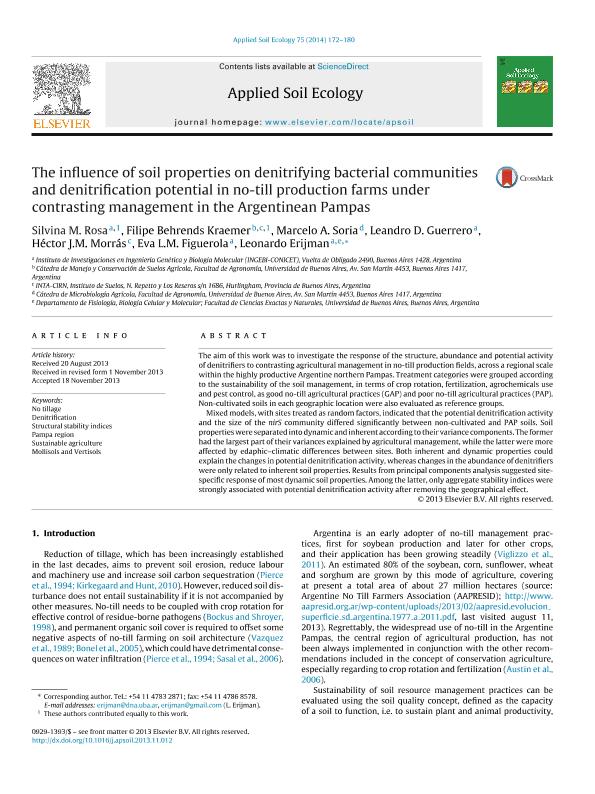Mostrar el registro sencillo del ítem
dc.contributor.author
Rosa, Silvina Mariana

dc.contributor.author
Behrends Kraemer, Filipe

dc.contributor.author
Soria, Marcelo Abel

dc.contributor.author
Guerrero, Leandro Demián

dc.contributor.author
Morrás, Héctor José María

dc.contributor.author
Figuerola, Eva Lucia Margarita

dc.contributor.author
Erijman, Leonardo

dc.date.available
2018-01-10T17:13:30Z
dc.date.issued
2013-12
dc.identifier.citation
Figuerola, Eva Lucia Margarita; Erijman, Leonardo; Morrás, Héctor José María; Soria, Marcelo Abel; Behrends Kraemer, Filipe; Rosa, Silvina Mariana; et al.; The influence of soil properties on denitrifying bacterial communities and denitrification potential in no-till production farms under contrasting management in the Argentinean Pampas; Elsevier; Applied Soil Ecology; 75; 12-2013; 172-180
dc.identifier.issn
0929-1393
dc.identifier.uri
http://hdl.handle.net/11336/32820
dc.description.abstract
The aim of this work was to investigate the response of the structure, abundance and potential activity of denitrifiers to contrasting agricultural management in no-till production fields, across a regional scale within the highly productive Argentine northern Pampas. Treatment categories were grouped according to the sustainability of the soil management, in terms of crop rotation, fertilization, agrochemicals use and pest control, as good no-till agricultural practices (GAP) and poor no-till agricultural practices (PAP). Non-cultivated soils in each geographic location were also evaluated as reference groups. Mixedmodels,with sitestreatedas random factors,indicatedthatthepotential denitrification activity and the size of the nirS community differed significantly between non-cultivated and PAP soils. Soil properties were separated into dynamic and inherent according to their variance components. The former had the largest part of their variances explained by agricultural management, while the latter were more affected by edaphic-climatic differences between sites. Both inherent and dynamic properties could explain the changes in potential denitrification activity, whereas changes in the abundance of denitrifiers were only related to inherent soil properties. Results from principal components analysis suggested site-specific response of most dynamic soil properties. Among the latter, only aggregate stability indices were strongly associated with potentialdenitrification activity after removing the geographical effect.
dc.format
application/pdf
dc.language.iso
eng
dc.publisher
Elsevier

dc.rights
info:eu-repo/semantics/openAccess
dc.rights.uri
https://creativecommons.org/licenses/by-nc-sa/2.5/ar/
dc.subject
No Tillage
dc.subject
Denitrification
dc.subject
Structural Stability Indices
dc.subject
Pampa Region
dc.subject
Sustainable Agriculture
dc.subject
Mollisols And Vertisols
dc.subject.classification
Otras Ciencias Biológicas

dc.subject.classification
Ciencias Biológicas

dc.subject.classification
CIENCIAS NATURALES Y EXACTAS

dc.subject.classification
Agricultura

dc.subject.classification
Agricultura, Silvicultura y Pesca

dc.subject.classification
CIENCIAS AGRÍCOLAS

dc.title
The influence of soil properties on denitrifying bacterial communities and denitrification potential in no-till production farms under contrasting management in the Argentinean Pampas
dc.type
info:eu-repo/semantics/article
dc.type
info:ar-repo/semantics/artículo
dc.type
info:eu-repo/semantics/publishedVersion
dc.date.updated
2018-01-08T19:50:37Z
dc.journal.volume
75
dc.journal.pagination
172-180
dc.journal.pais
Países Bajos

dc.journal.ciudad
Ámsterdam
dc.description.fil
Fil: Rosa, Silvina Mariana. Consejo Nacional de Investigaciones Científicas y Técnicas. Instituto de Investigaciones en Ingeniería Genética y Biología Molecular ; Argentina
dc.description.fil
Fil: Behrends Kraemer, Filipe. Universidad de Buenos Aires. Facultad de Agronomia. Departamento de Ingenieria Agricola y Uso de la Tierra. Cátedra de Manejo y Conservación de Suelo; Argentina. Instituto Nacional de Tecnología Agropecuaria. Centro de Investigación de Recursos Naturales. Instituto de Suelos; Argentina. Consejo Nacional de Investigaciones Científicas y Técnicas; Argentina
dc.description.fil
Fil: Soria, Marcelo Abel. Universidad de Buenos Aires. Facultad de Agronomía. Departamento de Biología Aplicada y Alimentos. Cátedra de Microbiología Agrícola; Argentina
dc.description.fil
Fil: Guerrero, Leandro Demián. Consejo Nacional de Investigaciones Científicas y Técnicas. Instituto de Investigaciones en Ingeniería Genética y Biología Molecular ; Argentina
dc.description.fil
Fil: Morrás, Héctor José María. Consejo Nacional de Investigaciones Científicas y Técnicas; Argentina. Instituto Nacional de Tecnología Agropecuaria. Centro de Investigación de Recursos Naturales. Instituto de Suelos; Argentina
dc.description.fil
Fil: Figuerola, Eva Lucia Margarita. Consejo Nacional de Investigaciones Científicas y Técnicas. Instituto de Investigaciones en Ingeniería Genética y Biología Molecular ; Argentina
dc.description.fil
Fil: Erijman, Leonardo. Consejo Nacional de Investigaciones Científicas y Técnicas. Instituto de Investigaciones en Ingeniería Genética y Biología Molecular ; Argentina. Universidad de Buenos Aires. Facultad de Ciencias Exactas y Naturales. Departamento de Fisiología, Biología Molecular y Celular; Argentina
dc.journal.title
Applied Soil Ecology

dc.relation.alternativeid
info:eu-repo/semantics/altIdentifier/url/http://www.sciencedirect.com/science/journal/09291393
dc.relation.alternativeid
info:eu-repo/semantics/altIdentifier/doi/http://dx.doi.org/10.1016/j.apsoil.2013.11.012
Archivos asociados
